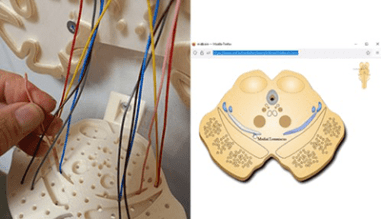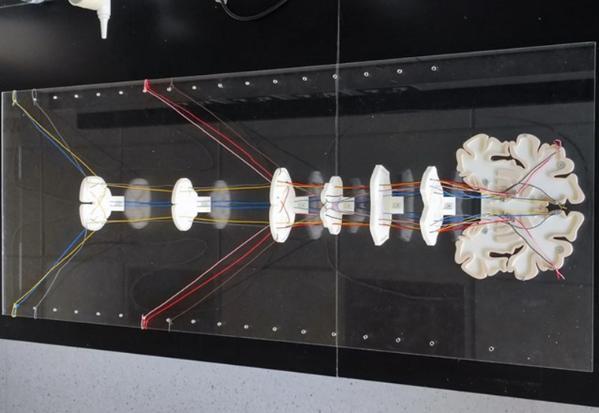Putting the ‘Multi’ into Multimedia Instruction in Neuroanatomy
Overview

This Learning Enhancement project has been funded through the HEA and the National Forum for the Enhancement of Teaching and Learning.
| PROJECT TITLE: | Putting the ‘Multi’ into Multimedia Instruction in Neuroanatomy |
|---|---|
| PROJECT COORDINATORS: | Dr. Tom Flanagan |
| COLLABORATORS: | Dr. Mark Pickering |
| MODULE/PROGRAMME: | ANAT20040 |
| STUDENT COHORT: | Full-time undergraduate Medicine, Stage 3 |
Background
Neuroscience is a highly complex, multidisciplinary subject, and both historically and globally, has been perceived by medical students as the most difficult and daunting subject of their studies. The vastness and complexity of neuroanatomy, in particular, and difficulty in visualizing neuroanatomical structures, have been postulated as major causes of ‘neurophobia’ in students. Innovative teaching strategies for assisting the simplification and understanding of neuroanatomical concepts, and particularly resources associated with improved three-dimensional (3-D) neuroanatomical visualization, are valuable tools to enhance neuroanatomy learning and dispel fears associated with the subject.
Several years ago, we developed a freely-available interactive multimedia e-learning resource – Animated eXploration of Neuroanatomy (AXON) – which was designed initially to improve spatial and functional understanding of sensory pathways in the body through self-paced animations. This proved to be a particularly useful resource during the COVID-19 pandemic, when students were reliant on and even dependent upon, online learning tools. However, on return to in-person teaching, it was clear that more hands-on practical materials were necessary to engage and immerse students further in such topics, and to reclaim some of the social elements of university learning that were lost during the pandemic.
By fostering universal design for learning (UDL) principles, we decided to explore alternative methods of engaging students in the same content – by extending the definition of ‘multimedia’ in the creation of instructional experiences. To this end, we proposed to create physical representations of the digital content that we had already created to bring the content to life for in-class engagement and group interaction.
Goals
Existing digital content
Our current interactive multimedia e-learning resource (AXON) focuses on a specific area of the pre-clinical Medicine neurosciences syllabus – namely the somatosensory system – the system involved in relaying various sensations from the body to the brain. Like many aspects of neuroscience, this is a dynamic process that students have difficulty understanding from 2-D diagrams in a textbook. The interactive animations in AXON used original images created in Adobe Illustrator which were subsequently animated using Motion software to illustrate the dynamic nature of the sensory pathways. These animations had been integrated into a webpage format using Adobe Fireworks and Dreamweaver to allow for an interactive user experience, primarily as a self-study resource.
Integrating a physical 'medium' using the digital template
By harnessing UDL principles and providing multiple means of representation and engagement, our specific goals in the current project were as follows:
- To create a 3-D printed physical model of the somatosensory system using our original digital content as a template;
- To integrate this physical model, together with the digital content, as an interactive learning activity in a 2-hour timetabled practical class;
- To evaluate the experience of the students using the two resources and to determine
- which method of content representation they preferred, and
- which method (if any) they felt had enhanced their learning of the topic more.
The Innovative Approach
In creating an alternative means of representation and engagement for the in-person interactive instructional experience, we proposed to create 3-D models of the nervous system and major components of the somatosensory pathways, that students could use to physically ‘wire-up’ the routes taken by nerve impulses from peripheral parts of the body to the brain. The idea was that this activity would foster discussion amongst students in a small-group setting, and provide them with an enhanced understanding of the pathways to the brain, their relationships and how damage to these pathways might affect sensation.
To create the physical models, we converted our original drawings of various nervous system components into scalable vector graphics (SVG) files, from which 3-D objects could be extracted in CAD software. In the CAD software, we edited these files further for 3-D printing and exported them as STL files, which were sliced for 3-D printing in a slicing software (PrusaSlicer). The objects were then 3-D printed and mounted onto Perspex sheeting to create the physical models. Whiteboard markers and different coloured reels of wire were provided to students in the timetabled in-class setting to draw on/label the Perspex sheeting and to thread the pathways of nerve impulses using the 3-D printed components.
After students had taken part in the practical session, they completed an in-class questionnaire using Mentimeter based on their experience of using both the digital and physical representations of the content, and were asked which method they personally preferred using for their learning (AXON vs physical model), as well as which method they felt enhanced their learning more (AXON vs physical model vs no difference).
Results
We were able to successfully fabricate 3-D printed physical models of the somatosensory system using our original digital content as a template (Figure 1). ANAT20040 students attended a 2-hour timetabled practical session that involved use of the interactive digital resource (AXON) and physical resource for 1 hour each.

Figure 1: 3-D printed spinal pathways model
After the practical, we invited students to take part in an in-class questionnaire using Mentimeter to gauge their preference between the resources:
- Of the 130 students who completed the questionnaire, 66 students (50.8%) personally preferred the digital resource, while 64 students (49.2%) personally preferred the physical resource (3-D printed model);
- When asked which resource gave them a better understanding of the content, 56 students (43.1) suggested the digital resource, 31 students (23.8%) suggested the physical resource, while 43 students (33.1%) suggested both resources were equal in this regard.
Some of the students favouring the digital resource quoted:
AXON had a thorough explanation of the content.
I preferred AXON because it was more detailed.
Some sample feedback from students that favoured the physical resource included:
I can see what’s actually happening instead of imagining.
Active learning is better than just watching.
Other students highlighted the complementary nature of the resources:
“Both helped me in different ways – they complemented each other helping me apply the knowledge from the interactive AXON content in the physical model.”
The resulting resource created is clearly most useful to those teaching neuroscience. However, some take-home messages to general educators include the following:
- Both digital and physical resources can be extremely useful in engaging students with educational content that is dynamic in nature and difficult to interpret and understand from two-dimensional images and text;
- The present study also strengthens the case for applying multiple means of representation and engagement (based on UDL principles) in delivering content to students, given that the preference and perceived benefits of each resource was shown to be quite even.
Resources
The project leads are happy to hear from educators who might be interested in either digital animated content creation, or 3-D model creation, for advice & assistance in setting up or implementing such approaches in their teaching practice.
Some of the material discussed in this project summary can be found at the sites below:
- Animated eXploration of Neuroanatomy (AXON)
- Spinal pathways model (resource shared to a web library for 3-D printing models, Printables.com)